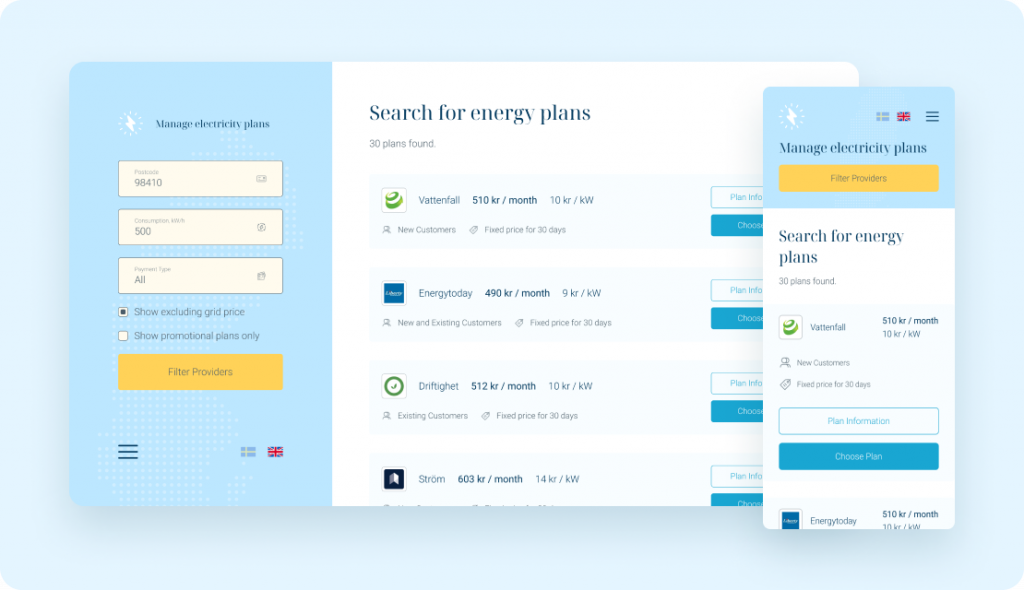
Electricity providers based on the user’s ZIP code
The MVP started gaining popularity and the base of users was quickly growing. That’s when our client decided to scale and bring the solution to Sweden. The second part of the project began.

If you’ve got a brilliant idea, we’re here to help you build an early product version and give it a shot in the market.
If you have an existing product and team, but looking to expand the capacity and try out a new concept, we’ve got you covered.
If you know what specific product you need to drive your industry market.
If you clearly know what technology can help your business achieve goals through the product.
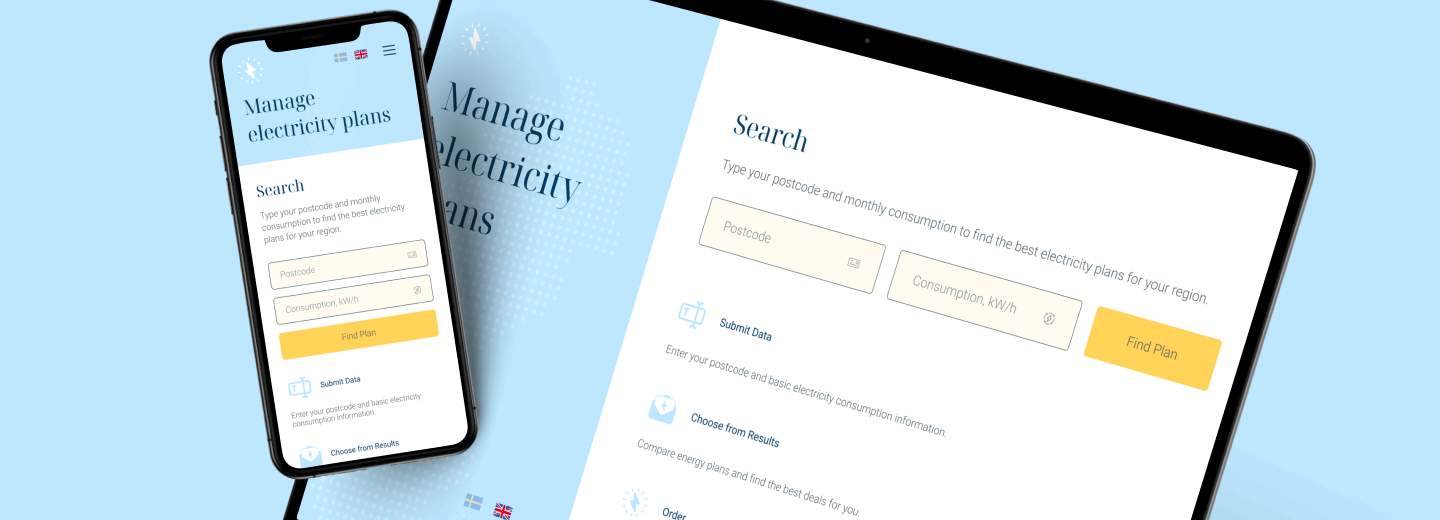
About the client
Our client, a Norwegian consulting company, has been working with industrial facilities such as enterprises and farms for years to help them manage their electricity costs and switch to a more profitable provider. As the process of digitalization advanced, they made the decision to transform their business into a digital format, enabling electricity consumers to conveniently locate the most suitable provider based on their specific location.
To help users save more on electricity costs, the company decided to launch a new startup, a platform that would connect all Norwegian providers, present their tariffs and filter the most suitable ones for the user to help people pay less every month. Such a solution would fit both providers and consumers, allowing the latter to easily switch between tariffs depending on their current needs.
To let users see all available electricity tariffs, compare prices and effortlessly switch between providers, our client had to build a web portal with the list of providers and their tariffs. They needed a dedicated development team able to transform the idea into reality – and that’s when EVNE Developers stepped in. We loved the idea and immediately started implementing it.
To bring the solution to live, we had to tackle several challenges. First of all, we had to create a database of all available electricity providers in Norway to connect them through a single system. Then we needed to implement key functionality – allow users to compare tariffs and choose the most suitable one. Finally, we had to connect the user with the provider to enable the payment process.

To build this platform, we started off by researching the Nordic electricity market. In close collaboration with our client, who had already secured contracts with the majority of Norwegian electricity providers, we thoroughly analyzed the market’s unique characteristics before starting the development process.
By establishing connections with over a hundred electricity providers, our initial focus was on delivering a Minimum Viable Product (MVP) that allowed us to gather valuable user feedback. The results exceeded our expectations – people started to actively use the platform and the website quickly acquired new clients.
Satisfied with the results, the client decided to scale the solution and enter new markets. The Norwegian platform – Strømtest – became the first part of our project. Later, we scaled this platform for the Swedish electricity market. Here’s the story of how we built it.
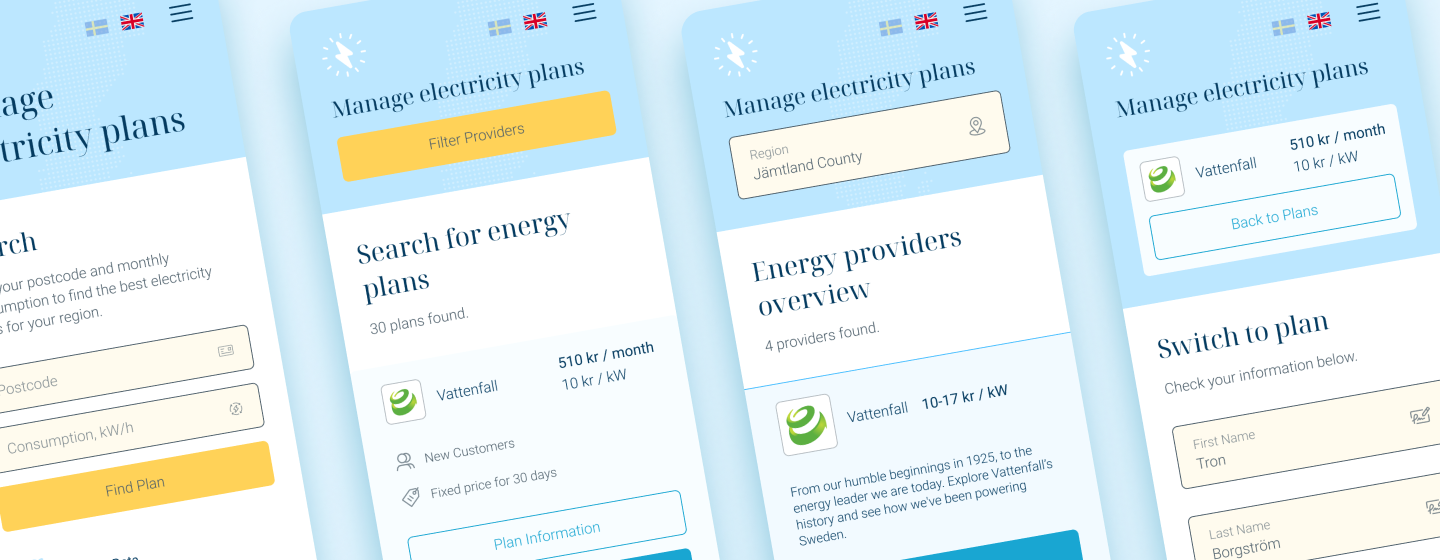
At the start of the development process, we had to overcome several major challenges. First, we had to create the list of all available electricity providers based on the regions they cover. For that, we had to gather data from three governmental resources:
The Norwegian Water Resources and Energy Directorate (NVE) for the licenses of providers that function in Norway.
Forbrukerradet for tariff prices and the possibility to connect with providers through an API.
Nordpool to see the providers’ territories of distribution.
Unifying the data from these open-source resources through APIs, we created a database of the Norwegian electricity providers with the regions they cover, enabling the key functionality of the future tool.
The next web platform we built was a Swedish analog of Strømtest but with extended functional scope and distribution approach. Already experienced, we knew how to implement the key functionality, but this version had to be more advanced than the previous one.
First of all, we needed to implement new features. For example, we had to provide users the possibility to access statistics on their selected tariffs. For users opting for flexible plans, it is crucial to have information about average prices over specific time periods. To facilitate this, we developed a personalized user account where individuals can view detailed statistics on the price fluctuations of their chosen tariff.
Apart from statistics, we needed to change the monetization method. For it, we set a goal of making the user stay on the platform for a longer period of time instead of switching to a provider website. So we added the possibility to pay for the tariff directly on the platform which basically converted it into SAAS platform for users and energy providers. As a user chooses a specific offer, the system sends their data to the provider through an API and subscribes them automatically, reducing transitions between sites.
We built a platform that serves as a universal tool for managing electricity costs. It provides the following features:

The MVP started gaining popularity and the base of users was quickly growing. That’s when our client decided to scale and bring the solution to Sweden. The second part of the project began.
The MVP started gaining popularity and the base of users was quickly growing.
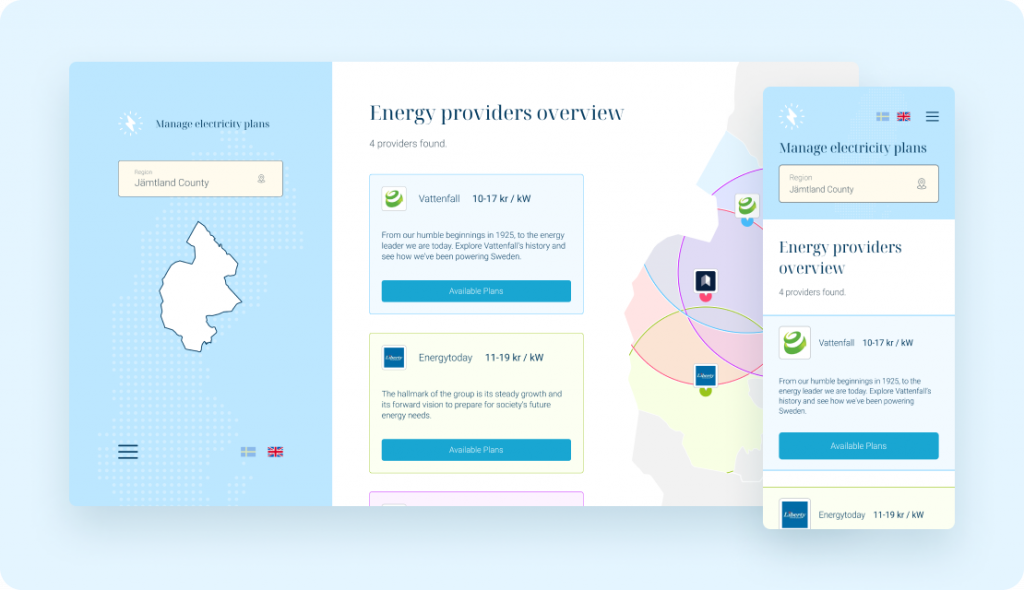
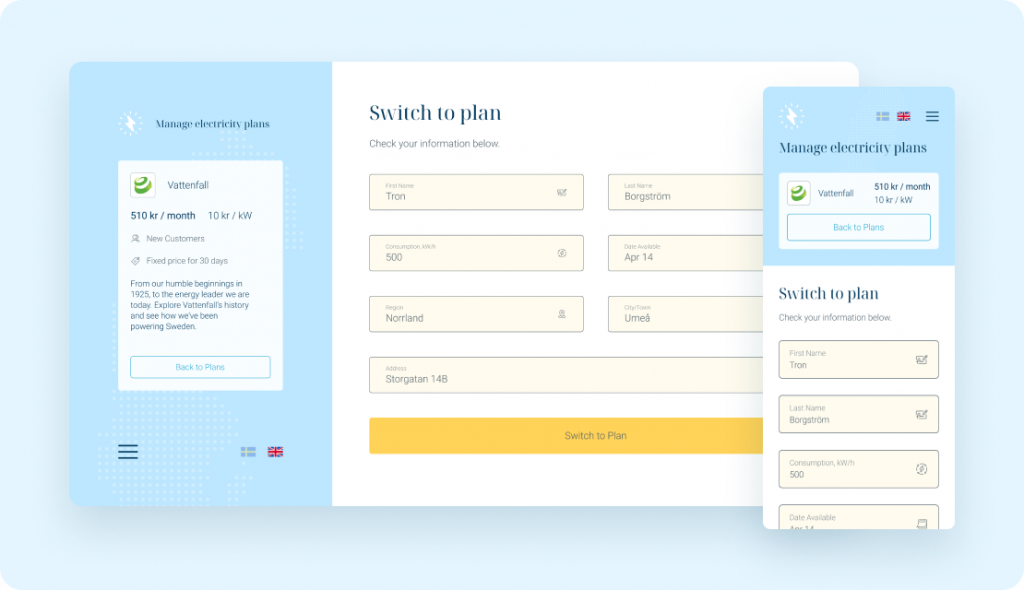
The MVP started gaining popularity and the base of users was quickly growing. That’s when our client decided to scale and bring the solution to Sweden. The second part of the project began.
To implement this functionality, we migrated the key features of Strømtest and enhanced them. It didn’t go without challenges, though, so here’s how we overcame them.
To make sure the platform’s list of providers is complete, we had to unify data from several sources. The main challenge was that data was too diverse. Some resources provided information based on the list of ZIP codes, some were based on the names of specific regions. We had to connect the ZIP code database with the regions so that users could enter their ZIP code and see all available providers.
To enable this feature, we took every region, checked its ZIP code, and matched it with the data about providers from open-source resources. Checking every provider, we ensured that the list is complete and has no discrepancies. To keep the list up-to-date, we continued to implement changes, adding new providers and excluding those that are no longer relevant.
To make sure the platform’s list of providers is complete, we had to unify data from several sources. The main challenge was that data was too diverse. Some resources provided information based on the list of ZIP codes, some were based on the names of specific regions. We had to connect the ZIP code database with the regions so that users could enter their ZIP code and see all available providers.
To enable this feature, we took every region, checked its ZIP code, and matched it with the data about providers from open-source resources. Checking every provider, we ensured that the list is complete and has no discrepancies. To keep the list up-to-date, we continued to implement changes, adding new providers and excluding those that are no longer relevant.
After that, we had to test the added functionality. To ensure that the platform is easy to navigate, we leveraged the JTBD framework, dividing users into 3 categories:
We also implemented 5-second tests to see if a person that sees the platform for the first time can understand how it functions. To conduct a more profound research, we carried out moderated user tests wherein a selected group of participants were assigned the task of subscribing to a tariff. A moderator then posed questions to gauge the clarity of the process and measure the time taken by users to complete the task. These tests allowed us to gather valuable insights into the user experience and identify areas for improvement in terms of clarity and efficiency.
Based on the research and tests, we upgraded UX and adapted the product for a new market.
For Ei, our goal was to make users stay on the platform for as long as possible, eliminating the need to switch to other websites. So we changed the monetization method used for Strømtest, making it moore straightforward and allowing users to pay for the chosen tariff directly on the platform.
To make payment convenient for Swedish citizens, we implemented a number of payment options that include the most popular systems on the market:
By adding the possibility to subscribe to tariffs right away, on the same platform, we enhanced the user experience.
Steady revenue flow
The platform we built allowed our client to gain a percentage from every lead generated. Acquiring 100K leads in a year, the product fully met our client’s expectations.
User-friendly interface
By conducting extensive research, rigorous testing, and employing UX design principles, we built a platform that offers great user experience. It meets the user needs and solves the problem of moving to a more favorable electricity tariff.
Scalability
After the first release in Norway, we scaled the solution for the Swedish market. Enhancing the product, we increased the client base and improved the solution’s functionality and design together with transition to a SAAS distribution model.

Co-Founder & Managing Director, Tariff Calculations Company
The company was happy with EVNE Developers. The team provided highly creative suggestions on top of the client’s technical requirements. They developed top-notch features for the product and managed the project using the agile methodology. They also kept the firm informed about their progress. We liked their expertise in the field and technology. That is proved by the stable work of the existing software and effective running of our business model.
EVNE Developers is a dedicated software development team with a product mindset.
We’ll be happy to help you turn your idea into life and successfully monetize it.


